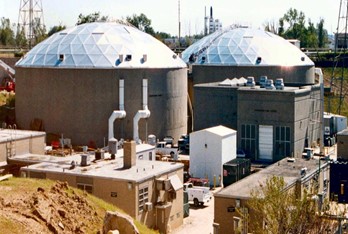About Us
We are one of the most respected forensic building consultants in the country. See why we are leaders.

The twin bio-roughing towers were constructed as part of a long-term expansion at the Morris Forman Waste Water Treatment Plant. Over one year after completion, the precast beams in Tower 2 failed catastrophically, causing the inward collapse of the media stack and the loss of use of the tower.
A bio-roughing tower is a trickle filter used in the secondary treatment stage of wastewater. Each facility consists of a cylindrical, cast-in-place concrete tank approximately 180 feet in diameter. Wastewater is sprayed down from a rotating arm at the top of the tank then filters through a stack of plastic media blocks 22 feet high. Biological Oxygen Demand is removed from the clear effluent by microorganisms attached to the media. The media block stack was supported from below by simply-supported, 8-foot-long precast concrete beams. The beams, in turn, were supported by a grid of cast-in-place concrete girders and columns.
Evaluation of the structural components of Tower 1 revealed significant distress, resulting in the ultimate shutdown of that tower as well. The concrete tank walls and cast-in-place concrete grids remained intact; however, subsequent removal of the damaged media blocks and precast beams was required.
RRJ performed an evaluation of the design and fabrication of the precast beams and detailed reviews of the construction and subsequent litigation documentation. Analysis of the design revealed that incorrect loading assumptions were made during the design process, resulting in structural inadequacy of the precast beams. Deficiencies were discovered in the placement of reinforcement steel within the precast members.
| Location | Louisville, Kentucky |
|---|---|
| Client | Kerrick, Grise, Stivers, & Coyle,PLC |
| Team | Kurt Hoigard |
| Services | Failure Analysis |
Ready to talk about your next project?